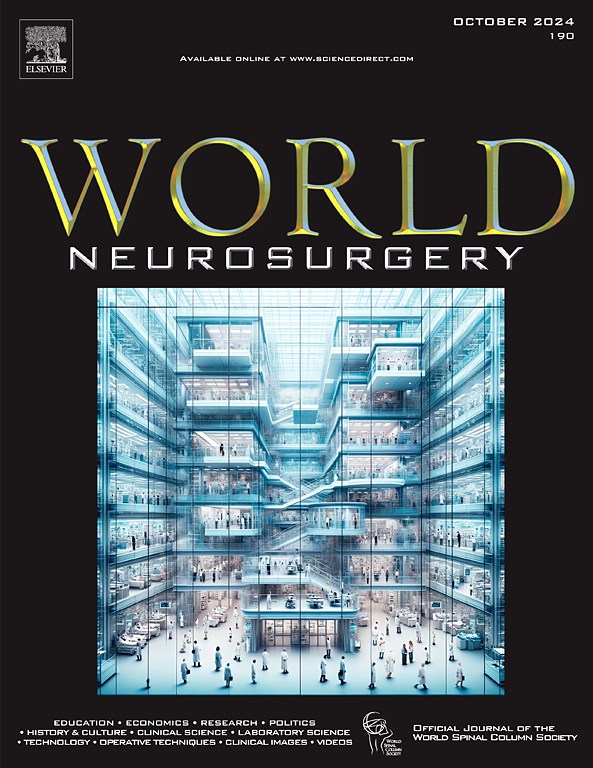腰椎远端短节段融合治疗复发性腰椎间盘突出症的椎盂预后:采用Roussouly分类的术前和术后比较分析。
IF 2.1
4区 医学
Q3 CLINICAL NEUROLOGY
引用次数: 0
摘要
目的:本研究旨在评估远端腰椎短节段融合(dSSF)对复发性腰椎间盘突出症患者脊柱骨盆参数和矢状位的影响,并根据Roussouly分类对结果进行分析。方法:一项回顾性单中心队列研究纳入了38例复发性腰椎间盘突出症患者,这些患者在2015年1月至2023年12月期间接受了开放的L4-L5或L5-S1 dSSF。术前和术后的脊柱参数,包括整体腰椎前凸(gLL)、近端腰椎前凸、远端腰椎前凸(dLL)、骨盆倾斜、骶骨倾斜和骨盆发生率-腰椎前凸(PI-LL)不匹配,使用Nucleus Software进行测量。将患者分为Roussouly型(RT-1 ~ RT-4)。统计分析椎盂参数比较采用配对t检验或Wilcoxon符号秩检验,RT分布采用卡方检验,P < 0.05。结果:该队列(女性20人,男性18人,平均年龄44.34±10.38岁)显示,术后rt1患者gLL(44.60°±17.64至48.70°±12.16,P = 0.027)、dLL(25.00°±10.17至27.70°±6.70,P = 0.009)、PI-LL不匹配(13.19°±17.50至3.40°±5.56,P = 0.008)均有显著改善。术后以RT-2为主(P = 0.006)。骨盆倾斜和骶骨斜度的变化在所有组中均不显著。RT-2、RT-3和RT-4显示最小的脊柱参数改变,表明对非低脊椎病的影响有限。结论:dSSF可显著增强gLL、dLL和PI-LL错配,尤其是在RT-1患者中,提示低椎体多裂脊柱矢状面平衡改善。有临床结果的更大规模的前瞻性研究有必要验证长期疗效。本文章由计算机程序翻译,如有差异,请以英文原文为准。
Spinopelvic Outcomes of Distal Lumbar Short-Segment Fusion in Recurrent Lumbar Disc Herniation: A Preoperative and Postoperative Comparative Analysis with Roussouly Classification
Objective
This study aimed to assess the effects of distal lumbar short-segment fusion (dSSF) on spinopelvic parameters and sagittal alignment in patients with recurrent lumbar disc herniation, with outcomes analyzed according to Roussouly classification.
Methods
A retrospective single-center cohort study included 38 patients with recurrent lumbar disc herniation who underwent open L4-L5 or L5-S1 dSSF between January 2015 and December 2023. Preoperative and postoperative spinopelvic parameters, including global lumbar lordosis (gLL), proximal lumbar lordosis, distal lumbar lordosis (dLL), pelvic tilt, sacral slope, and pelvic incidence-lumbar lordosis (PI-LL) mismatch, were measured using Nucleus Software. Patients were categorized into Roussouly types (RTs) (RT-1 to RT-4). Statistical analyses employed paired t-tests or Wilcoxon signed-rank tests for spinopelvic parameter comparisons and chi-square tests for RT distribution, with significance set at P < 0.05.
Results
The cohort (20 females, 18 males; mean age 44.34 ± 10.38 years) showed significant postoperative improvements in gLL (44.60° ± 17.64 to 48.70° ± 12.16, P = 0.027), dLL (25.00° ± 10.17 to 27.70° ± 6.70, P = 0.009), and PI-LL mismatch (13.19° ± 17.50 to 3.40° ± 5.56, P = 0.008) in RT-1 patients (n = 19). RT-2 became predominant postoperatively (P = 0.006). Pelvic tilt and sacral slope changes were insignificant across all groups. RT-2, RT-3, and RT-4 showed minimal spinopelvic parameter alterations, indicating limited impact in nonhypolordotic profiles.
Conclusions
dSSF significantly enhances gLL, dLL, and PI-LL mismatch, particularly in RT-1 patients, suggesting improved sagittal balance in hypolordotic spines. Larger prospective studies with clinical outcomes are warranted to validate long-term efficacy.
求助全文
通过发布文献求助,成功后即可免费获取论文全文。
去求助
来源期刊

World neurosurgery
CLINICAL NEUROLOGY-SURGERY
CiteScore
3.90
自引率
15.00%
发文量
1765
审稿时长
47 days
期刊介绍:
World Neurosurgery has an open access mirror journal World Neurosurgery: X, sharing the same aims and scope, editorial team, submission system and rigorous peer review.
The journal''s mission is to:
-To provide a first-class international forum and a 2-way conduit for dialogue that is relevant to neurosurgeons and providers who care for neurosurgery patients. The categories of the exchanged information include clinical and basic science, as well as global information that provide social, political, educational, economic, cultural or societal insights and knowledge that are of significance and relevance to worldwide neurosurgery patient care.
-To act as a primary intellectual catalyst for the stimulation of creativity, the creation of new knowledge, and the enhancement of quality neurosurgical care worldwide.
-To provide a forum for communication that enriches the lives of all neurosurgeons and their colleagues; and, in so doing, enriches the lives of their patients.
Topics to be addressed in World Neurosurgery include: EDUCATION, ECONOMICS, RESEARCH, POLITICS, HISTORY, CULTURE, CLINICAL SCIENCE, LABORATORY SCIENCE, TECHNOLOGY, OPERATIVE TECHNIQUES, CLINICAL IMAGES, VIDEOS
 求助内容:
求助内容: 应助结果提醒方式:
应助结果提醒方式:


